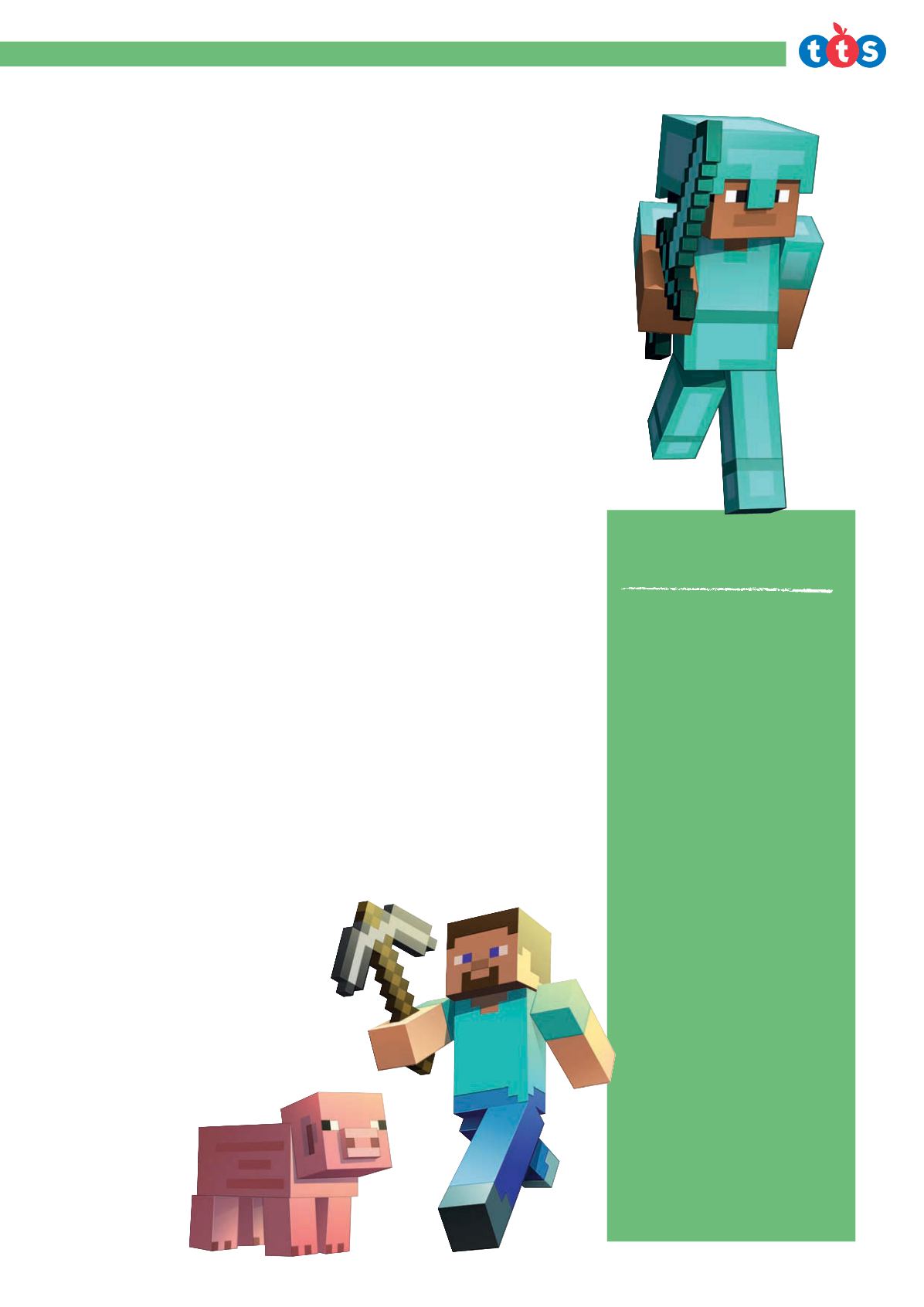
Settingupavirtual
writingworld
1
WHERE DOWE START?
Minecraft EDU is relatively simple
to use in school. You need to
purchase a server license and then
individual licences for each computer
that will run the program. (We opted to
buy a licence for every other computer
and allow children to work 2:1.)
When I introducedMinecraft tomy
class, almost every child already knew
how to use it, whichmeant we didn’t
have to spend several sessions just
getting to grips with the basics.
2
IS IT SAFE?
As the server is hosted in your
school, you can be certain it will
be safe for the children to use – the
outside world cannot get in. Just be
sure to run through a few e-safety
rules with your class regarding giving
respect to other people’s designs and
how to give structured, constructive
feedback.
3
TAKE IT HOME
You can continue the learning
conversation outside of school
by setting up an online community. We
use Edmodo, which allows children to
share and discuss screenshots from
Minecraft. (It’s an app we use for a lot
of flipped learning at the school.)
If at any point you get stuck, all the
information you will ever need is on
minecraftedu.com
‘Lost Chapter’ that was never published. And
since this remained amystery, it was down
to themtowrite their own, creating a new
character, chocolate bar or sweet, and room in
which the action could take place.
This iswhereMinecraft came in. To
help children imagine and describewhat the
new roommight look like, theywouldfirst
build their own chocolate factory in the
gameworld.
Theywent wild. Engaged? I think so
– I couldn’t stop themtalking about it.
After the children had calmed down,
I explained how the processwould help
themtowrite – describing how the
detail of theirmodel could cross over
into their compositions.
Buildingskills
The beauty of usingMinecraft EDU is that the
whole class can collaborate on one project in
real time. Thismeant I could literally see the
chocolate factory being constructed around
me, with corridors, pipes, windows, chimneys,
strangemachines and even the oddOompa
Loompa in chocolate rooms.
I was blown away at the level of detail the
children had included in their designs. Some
even used ‘redstone’ (aMinecraft substance
that transmits power and can be used to
operatemechanismsuch as door and pistons)
tomake theirmachinesmove andwork – a
future electronics lesson, perhaps?
Was itworth
theeffort?
Could I have just asked the children to design
their chocolate roomon paper?Yes, but I’ve
done that in the past and, by comparison,
usingMinecraft took this to another level.
The childrenwere able to talkwithmuchmore
confidence about their creations – they could
walk you through the space.
I designedmy own roomalongside the
children and remember thinking: this iswhy
I became a teacher. The classroomwas alive
with talk of confectionary andmachines;
I already had a hunch I’d be reading some
cracking pieces of writing as a result.
Aword of caution at this stage. One
mistake people oftenmakewhen using
technology is to forget everything they know
is good practice. We can’t lose sight of the
fact that computers and gamesmust still
go hand in handwith quality-first
teaching.
Inmy project,
the technology
was only there
to enhance the
children’swriting
– the outcome
was for children towrite a newchapter for the
book – not build a 3Ddigital chocolate factory.
So I used theworkwe’d done inMinecraft as
the basis for sharedwriting; I wrotemy own
chapter using the chocolate room I had built
as inspiration, then analysedmyworkwith the
children, looking at whatmade it engaging to
the reader.
We played aroundwith language, created
some effective sentences, and looked at
speech and how it canmove a story on. The
writing skills still needed to be taught, but
we had awealth of things towrite about. It
was interesting to see the children ask for
more adventurous language to describe their
machines and extending sentences – there
was somuch theywanted towrite about.
Beforewe began towrite, I fired up the
server again and allowed the children to
explore each other’s rooms and ask questions
about the chapters theywere about to
write, e.g. ‘Howdid your newcharacter get
into trouble?’ They answeredwith such
confidence. They knewwhere the characters
entered the space, what they saw, where in
the roomthemachineswere located and how
their protagonists got up tomischief – all
because ofMinecraft.
The children sat andwrote. And theywrote
and theywrote. Theywroteflat out for two
sessions, withoutmuch prompting
or encouragement fromme. The level of detail
in their writingwas such that I couldmatch
each piece to theMinecraft roomonwhich it
was based.
UsingMinecraft turned out to be a
masterstroke. Thewriting process itself
didn’t change all thatmuch, but we sometimes
forget children cannot write creatively about
things they have never experienced. And
walking round a chocolate factory, albeit a
virtual one, makes all the difference.
Readmore about ChrisWaterworth’s work at
videoformyclassroom.blogspot.co.uk
TEACH READING & WRITING
73
In association with


